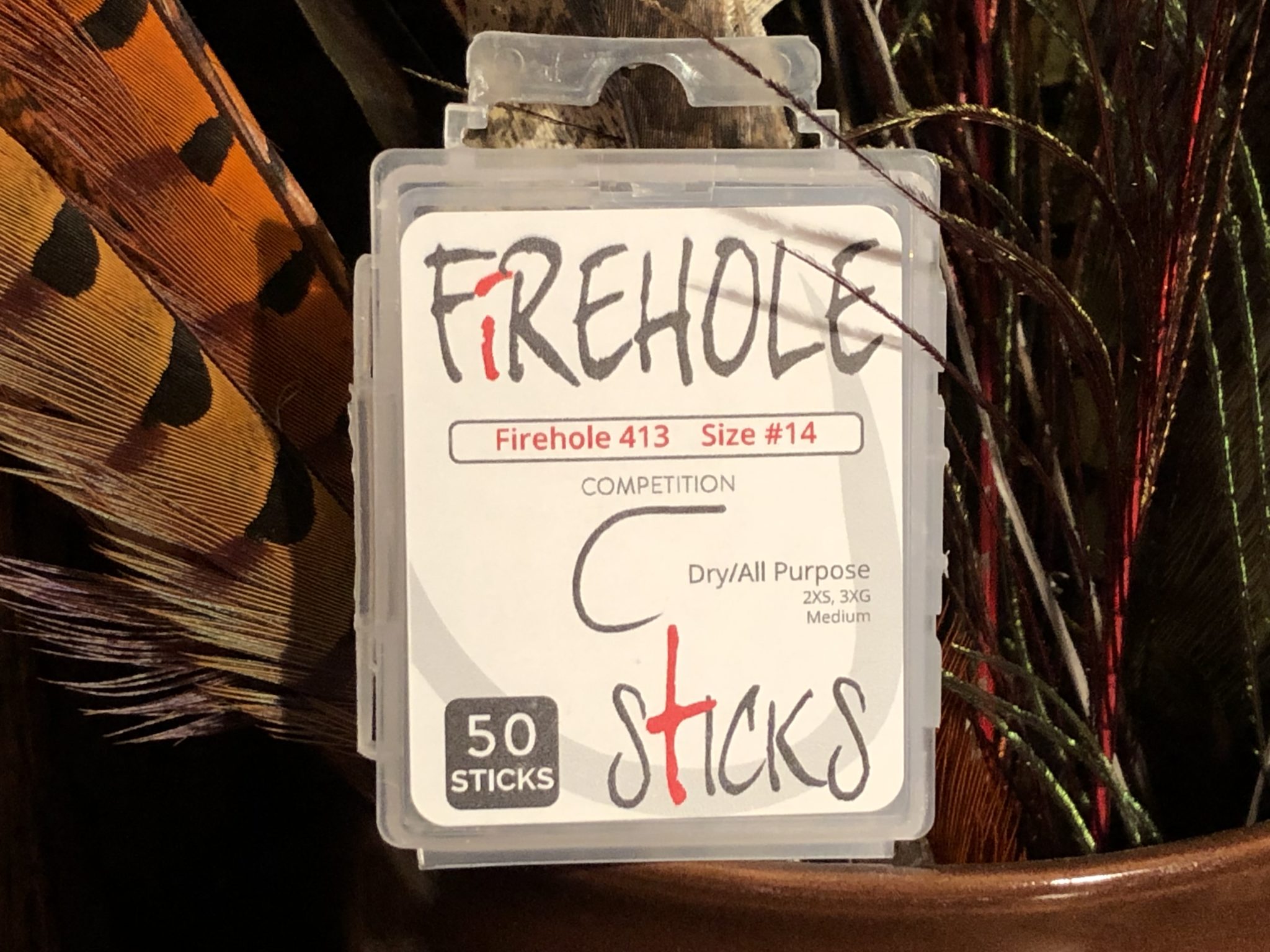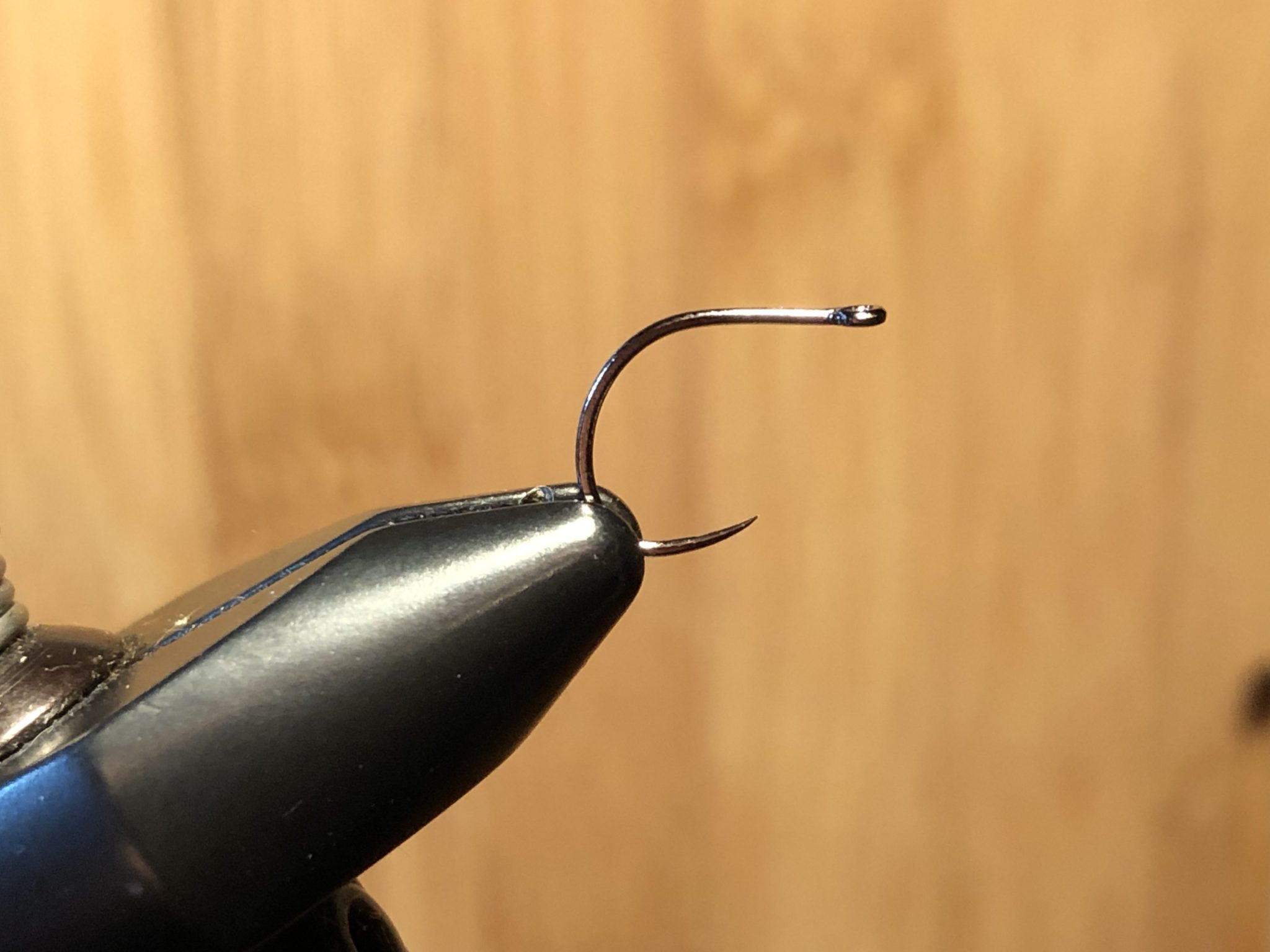
If you follow my fly tying at all, you probably know I’m a big fan of Firehole Sticks hooks from Firehole Outdoors. I wrote a post not too long ago about their #315 and #633 competition hooks and have been using them avidly ever since. As I mentioned, they’re high quality all around: strong, sharp, and come in bends that are well-suited to tenkara flies. Plus, I like the fact that they’re barbless and the price-to-quality ratio is better than any hook I know of on the market today. I was about to place another order to replenish my stock of 315s when I noticed their model #413. They looked interesting so I thought I’d give them a try.
They’re the same quality I’ve come to expect from Firehole with a sexy black nickel finish and really aggressive bend. The #413 is a medium-weight 2X short hook with a 3X wide gape.

While I talked to Firehole owner Joe Mathis about the possibility of developing tenkara-specific hooks and he wasn’t really interested, the 413s are very tenkara-esque–with a dramatic bend that suits sakasa kebari well and a super-wide gape for better hook sets when moving the fly.


I really like the aggressive profile these hooks create and the more angular bend (compared to the more rounded 315s) is already giving me some new ideas. To learn more and see current pricing, visit the Firehole Sticks 413 page.









Jason,
Have you looked at the 516’s for Tenkara style flies?
I do one with an undersized Stone bead that performs very well.
Hey Chris, believe it or not, I haven’t tried tying jig-style flies yet! Though I’ve seen some really interesting grayling patterns that I think would work well on some of the front-range streams and am thinking of giving it a try. I’ll probably order some. If you have any other patterns that you like with the 516s, please share.
Hi Jason. I also recently purchases a size range of the Fire Hole Sticks in # 413s, for tying midge pupae patterns on and I like them equally as well as you do. I guess it is partly an inherent component of Competition Style Hooks, with their comparatively larger gapes to ensure better hooking performances for competitive anglers, that they are running a hook size bigger than their rated hook size numbers would indicate on the boxes they come in. So if you want to tie a true size #12 fly pattern to present to the fish, tie it on the size #14 hook style of your choice with the Sticks Hooks, and so on and so forth.
While you have stated to me in the past that the size difference is meaningless for you, it may be more meaningful to other anglers reading your blog, that’s why I am passing this information on after buying a box of hooks I ended up not being able to use. I ended up giving them to a friend who could use them, so nothing at all was lost. I believe anyone who invests in the Sticks Hooks will be very impressed with them, as well as you and I are….Karl.
Hey Karl, good points. There are some TMC hooks like that. They call them a #22, but in my mind, they’re an 18. Every manufacturer is different and I think they base their size rating off the hook shank, but even though two hooks rated a #20 could have the same hook shank length, the one with the wider gape might give the overall impression of being a larger hook. Anyway, that’s why it’s wise to look at each individual hook and take the manufacturer’s rating system with a grain of salt.
I’ve found the size 20 Firehole Sticks 413 to be an excellent choice for tying the Stewart Black Spider. I fish this fly to great effect when fish are taking small prey items (usually midges, but we also have some very small black winter stoneflies) in the film.
Hi Jason. I have a Tenkara friendly (It does not weigh too much to cast and has very little wind resistance.) Jig Hook Fly pattern for you and all to try: I call it The Herl Thing.
The herl is one flue of Mini-Barred Ostrich herl that comes in Chartreuse, Olive, Purple, Red, Orange, White, and King Fisher – Blue, all with Mini-Black Bars, that makes up the tail, palmered body hackle, and the collar hackle with only a single feather flue. The other tying materials include: Brassy sized copper wire and 8/0 or 70 D FL- tying thread, and that’s it. It’s a quick and easy to tie pattern, surprisingly durable, and the tail will wiggle like crazy with or without having to pulse the fly.
To tie the fly (which is a more elegant take on the Mop Fly than a Mop Fly is), you slide a 1/8″, Black, Center Drilled Brass or Nickle Bead on to the hook (small hole toward the eye of the hook) and place it in the vice. Tie in the thread right behind the bead. Stick the wire in the bead Head and wrap it down on top of the hook shank (in touching wraps) to the hook bend. Then tie the herl in at the bend to form a tail about 1.5 times the hook shank in length, then fold and secure the tag end of the herl back and out of the way. Now wrap the thread (in touching wraps) back up to about 1/8″ shy of the bead head. Palmer-wrap the herl forward (so that you have evenly spaced bands of the thread color showing through the herl wraps on the hook shank) to the waiting thread and half-hitch. Rib the fly with the wire right down the center of the thread bands to the waiting thread, and then do touching wire wraps to the back of the bead head in front of the herl, tie off and break the wire away. Wrap a collar hackle over the tight wire wraps with the remaining herl and Whip Finishthe thread to form a thread FL-Hot Spot right behind the bead head to complete the fly. Pull the tail forward and trim it to a consistent length just in front of the hook’s eye. If desired, put a dab of head cement on the back of the bead and let gravity pull it down onto the thread Hot Spot, with out it getting the cement into the herl and you are all done.
I tie the Herl Thing in a #12 Olive/FL-Yellow thread combination, a #14 White/FL-Fire Orange thread one, and a size 14 King-Fisher Blue/ FL-Chartreuse Thread model. Of the 3, the Blue/Green one has pulled fish the greatest distances the quickest in gin clear/ blue colored water. But please feel free to tie what ever color combinations you and your fish like the best.
Here is a link so you can easily see just what the Mini-Barbed Ostrich Herl Pieces look like:
https://catalog.theflyshop.com/barred-ostrich/
This is available from other suppliers as well ( I chose this one for the quality of the photographic representation and not necessarily to plug this business.) and the colors offered may vary with different vendor/suppliers also.
Hey Karl, this is really interesting. Do you happen to have any pics of the finished fly you could post here?
Jason, I do not have any pictures of these fly patterns but, perhaps, this will help:
The Herl Thing Fly Pattern
Postby Karl Klavon » Thu Mar 17, 2016 5:19 pm
Here is an easy to tie and short materials list nymph fly pattern that I did well with last season in stillwater T-angling. For running water fishing, you might want to go to using a tungsten bead head instead of the nickle/brass variety.
Materials List
Hook……………….Orvis AB. Tactical Jig Hook or UFMC 400BL, #14 hook
Bead……………….7/64″ or 2.8 mm DIA Black nickle or brass bead
Thread…………….WUT 70 denier FL-chartreuse Thread
Rib…………………..Brassie sized natural colored copper wire
Tail…………………..1.5 hook shank length section of Olive/Black Barred Ostrich Herl
Palmer Hackle…. A continuation of the Tail Herl
Collar Hackle…… A continuation of the Palmer Hackle Herl
Tying Instructions:
1. Thread the bead on to the hook with the smaller hole facing the eye of the hook, and put the hook in your vise.
2. Tie in the thread right behind the bead.
3. Tie the rib wire in right behind the bead and bind the rib wire down on top of the hook shank back to the hook bend.
4. Tie the barred Ostrich herl in so it forms a 1.5 times the hook shank length tail, and then wind the thread tightly back up to the bead without tying the excess ostrich herl down.
5. Now, wrap the remaining ostrich herl once around the tail and then in evenly spaced wraps (palmer style) up to the thread waiting at the bead and tie it off.
6. Next, wrap an evenly spaced copper wire rib in between the palmer herl wraps, and tie it off at the back of the bead, helicopter winding the wire until it breaks out from under the securing thread wraps.
7. Now wrap the remaining ostrich herl back and forth to form a fatter thorax / collar / hackle and tie it off right behind the bead, while pulling and holding the waste back and out of the way while doing a 5-turn whip finish.
8. Now trim the excess herl away at the same height as the collar hackle, and then apply head cement to the back of the bead so it will run down and coat the thread Hot Spot in between the bead and the collar hackle with out being absorbed by the herl too much. Once the head cement drys, your fly is complete.
Re: The Herl Thing Fly Pattern
Postby Karl Klavon » Sun Mar 20, 2016 8:04 am
Here is a picture and some additional information on another almost exclusive ostrich herl fly pattern, the most interesting characteristic of these flies is the tail wiggle and the body and hackle fiber motion in the water that drives fish crazy. Here is the link: https://swittersb.wordpress.com/2011/02/25/fly-tying-ostrich-herl-2/
Now, try and emagine that fly with only a single tail, the whole fly tied with only a single Barred Ostrich Herl, on the hook with a black bead head to look like an eye to the fish, and the fly riding in the water as the hook is pictured point up, for far fewer bottom snags while fishing: http://www.orvis.com/p/tactical-jig-hook/1p2a
And here is a link to a picture of and a source for the Barred Ostrich Herl that I use to tie the Herl Thing fly pattern with: https://catalog.theflyshop.com/barred-ostrich/
Here is a video tying a mini-leach with 3-Ostrich Herls, wire and thread but it will give a good idea of the posabilities: https://www.youtube.com/watch?v=ALIYKd-afUM
Unfortunately Hareline & Co. has decided to discontinue offering the Mini-Barred dyed Ostrich Herl Pieces, so when present stocks are all used up it will no longer be available. Lure Parts Online, Inc (Item Number OBP271) has limited supplies and colors marked down to $2.99 EA, if anyone is interested. It may be more readily available in the UK.
Of course, regular ostrich herl in any color you and the fish like will give exactly the same great wiggle action in the water, but it will not be quite as visually stimulating as the Grizzly finished ostrich herl is or was….Karl.